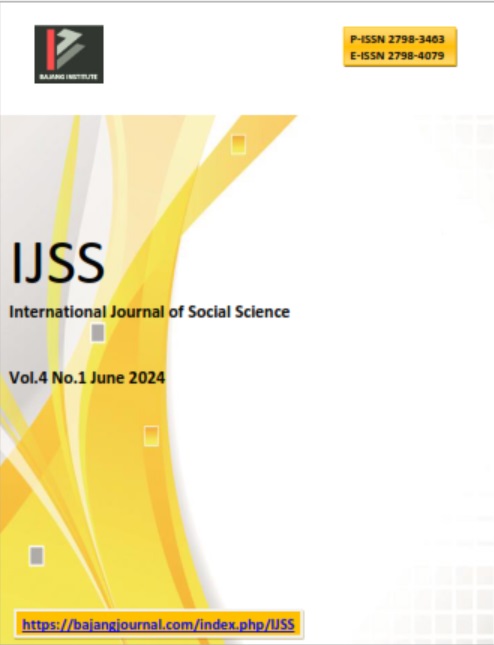ADOPTION OF THE TEACHING CAMPUS AS A STUDENT LEARNING MEDIA (Case Study of Students Participating in the Teaching Campus)
DOI:
https://doi.org/10.53625/ijss.v4i1.8001Keywords:
Adoption, Innovation, Students, Teaching CampusAbstract
The purpose of this research is to determine the process of spreading Teaching Campus Program innovations and the decision process for accepting (adopting) Teaching Campus Program innovations, especially at stage III. To realize the research objectives, this research uses qualitative research methods with a constructivist paradigm. Through the constructivist paradigm in question, researchers can describe social reality, through direct and detailed observations of Campus Teaching Program participants who utilize digital media naturally and see these activities in real life, creating a construction process by remembering and re-expressing experiences, the ability to compare and make decisions. from the results of interviews, and observations. The research results show that the diffusion process which includes relative, advantages, and compatibility elements strengthens the innovation adoption process. The decision process for accepting (adopting) the Campus Teaching Program III innovation goes through the same adoption stages based on the order of the 5 adoption stages proposed by Rogers, namely knowledge, persuasion, decision, implementation, and confirmation. The adopter category based on how quickly they accept the Campus Teaching Program III innovation is divided into four types, namely: innovators (innovators), early adopters (pioneers), early majority (followers), late majority (late followers).
References
R. Indonesia, Peraturan Menteri Pendidikan dan Kebudayaan Republik Indonesia Nomor 3 Tahun 2020 tentang Standar Nasional Pendidikan Tinggi. Indonesia, 2020.
Direktorat Jenderal Pendidikan Tinggi, Buku Panduan Merdeka Belajar Kampus Merdeka, I. Jakarta: Direktorat Jenderal Pendidikan Tinggi Kemdikbud RI, 2020.
Kemdikbud, “Transformasi Pendidikan Tinggi Melalui Implementasi Kampus Merdeka dan Reka Cipta,” www.kemdikbud.go.id, 2020. https://www.kemdikbud.go.id/main/blog/2020/09/transfsormasi-pendidikan-tinggi-melalui-implementasi-kampus-merdeka-dan-reka-cipta.
Malyana, “Pelaksanaan Pembelajaran Daring dan Luring dengan Metode Bimbingan Berkelanjutan Pada Guru Calon Konselor,” J. Ilm. Pendidik. Dasar Indones., vol. 2 (1), no. 1, pp. 67–76, 2020, [Online]. Available: https://doi.org/10.52217/pedagogia.v2i1.640.
E. M. Roger and F. F. Shoemaker, Communication of Innovations. London: The Free Press, 1971.
H. F. Lionberger and P. H. Gwin, Communication Strategi A Guide for Agricultural Change Agents, III. Danville: Interstate Printers and Publishers, 1982.
Soekartawi, A. Soeharjo, J. L. Dillon, and B. J. Hardaker, Ilmu Usaha Tani dan Penelitian untuk Pengembangan Petani Kecil. Jakarta: UI Press, 2011.
I. Sahin, “Detailed Review Of Rogers ’Diffusion Of Innovations Theory And Educational Technology-Related Studies Based on Rogers’ Theory,” Turkish Online J. Educ. Technol. - TOJET, vol. 5, no. 2, pp. 14–23, 2006.
E. M. Rogers, Difussion of Innovations, Fourth edi. New York: FP, 1995.
Ardianto and A. Bambang Q, Filsafat Ilmu Komunikasi. Bandung: Simbiosa Rekatama Media, 2007.
M. Fitrah and Luthfiyah, Metodologi Penelitian; Penelitian Kualitatif, Tindakan Kelas dan Studi Kasus. Sukabumi: CV Jejak, 2017.
S. Wahyuni, Qualitative Research Method: Theory and Practice. Jakarta: Salemba Empat, 2012.
Downloads
Published
How to Cite
Issue
Section
License
Copyright (c) 2024 Yuni Tresnawati, Saeful Mujab, Anindita Anindita, Muhamad Husni Mubarok

This work is licensed under a Creative Commons Attribution 4.0 International License.

















